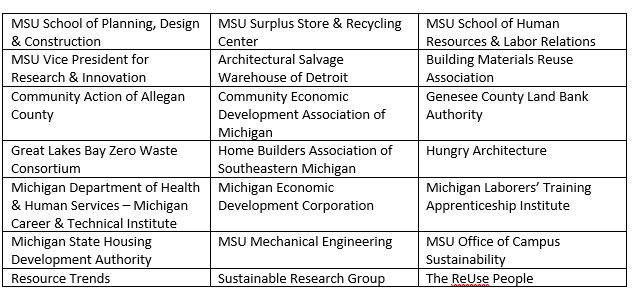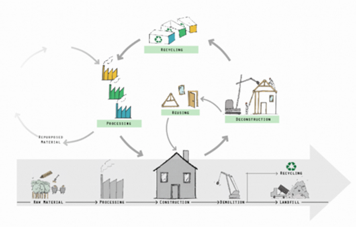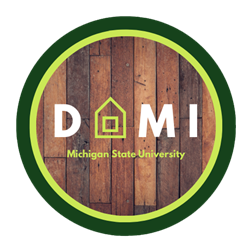Unlocking a Circular Economy for Salvaged Lumber
The cHALLENGE
Construction and demolition (C&D) waste makes up approximately 25%-40% of total landfill waste in Michigan. Nationally, more lumber is landfilled than harvested from the National Forest System each year. This illustrates a significant opportunity to recover salvaged timber from residential and commercial structures for use as feedstock for added value construction applications such as cross-laminated timber (CLT), nail-laminated timber (NLT), and glue-laminated timber (Glulam). In general, these applications have demonstrated high performance, often beyond that of traditional building materials, while holding the promise of greater economic and environmental benefits by closing the loop of a circular economy.
Previous studies by Michigan State University Center for Community and Economic Development (CCED) Domicology team have determined that the industry has the potential to employ nearly 200,000 workers and generate more than $80 million in annual sales. The studies suggest that there is sufficient supply of structural lumber in vacant homes in the Great Lakes region to support this industry, but the underdeveloped market for the salvaged material has constrained collection and reuse.
As an emerging field of study, Domicology fundamentally challenges the linear development paradigm; applying circular economic systems and lifecycle thinking to leverage substantial positive social, environmental, and economic impact from the presence of blighted and abandoned structures. Finding innovative strategies to maximize recovery and reuse of wood from abandoned structures marks a unique challenge and substantial opportunity for growth in our states material reuse sector.
The Team
To develop this market and unlock the supply of salvaged lumber, CCED has pulled together an extensive team to conduct research and create a statewide accelerator to improve the viability of this nascent industry. The team received a Recycling Market Development Grant from EGLE in 2019 ($384,188.53), which they matched with $222,347.35 of in-kind support.
Project partners include the following:
The Solution
The project focuses on two points that can help advance the industry:
Conduct pioneering research on value added reuses of salvaged organic products (wood) present in abandoned structures to bring that material back into the marketplace; and
Create a statewide salvage/reuse business accelerator that will provide strategic training, technical assistance, and networking to improve the viability of this nascent industry sector, and expand businesses’ recycling markets for salvaged materials.
The Results
The outcome of this project will be the publication of a market analysis report in 2021 and the establishment of a Technical Assistance (TA) Network. The report will include analysis based on outcomes from:
Fundamental material research regarding the suitability of different applications for salvage lumber, their performance, and economic and environmental impacts;
Surveys and interviews of re-use businesses;
Focus groups with residential and commercial construction industries;
Case studies with mature businesses in the salvage retail sector; and
Lessons from TA Network engaged scholarship projects.
This report and TA Network can be used as a key resource for developing and executing projects, businesses, and work plans within the industry.
Videos and Pictures
Provided by the Domicology Team





